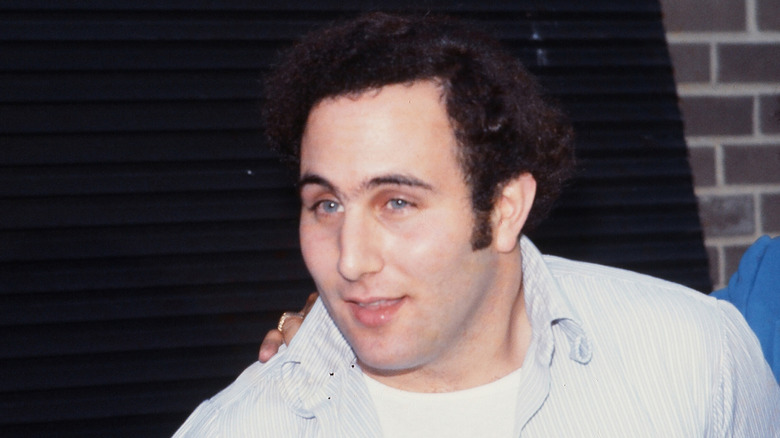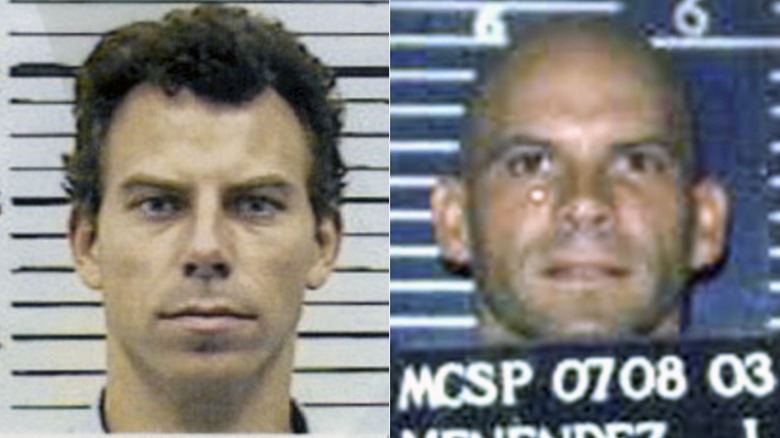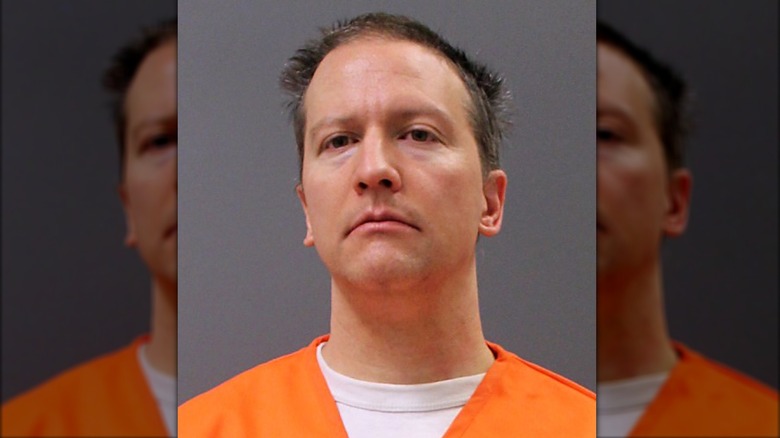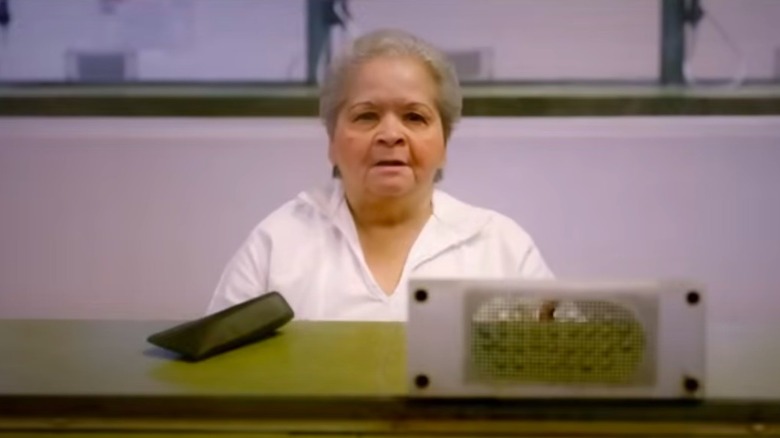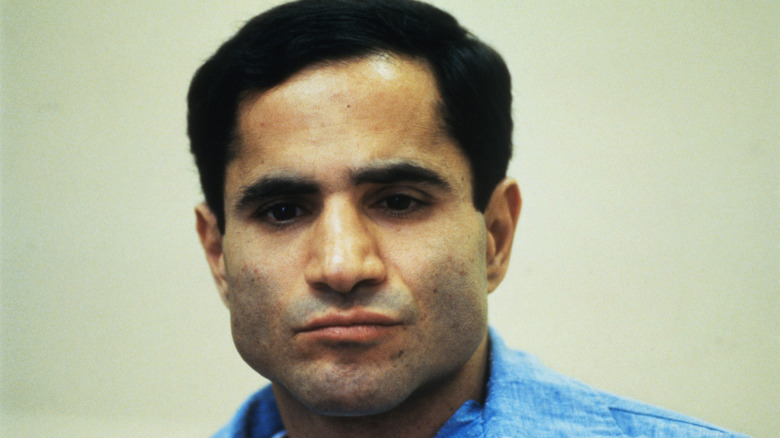Inside The Prison Lives Of Modern-Day Killers
The sheer amount of true crime podcasts, newsmagazine shows, and made-for-TV Lifetime movies provides ample evidence that there remains an insatiable thirst for real-life stories of murder. Whether serial killers such as John Wayne Gacy, Jeffrey Dahmer, and infamous Son of Sam murderer David Berkowitz, or those who've murdered their spouses/significant others and nearly got away with it, there's clearly some sort of psychological satisfaction achieved when murderers are captured and brought to justice, perhaps allowing us to feel there is some measure of order in an otherwise chaotic world.
After the public becomes spellbound by their trials and the often sordid revelations they reveal, the killers are convicted and sentenced, and either sent to the slammer for the rest of their days or for a date with the Grim Reaper. Many infamous figures have spent so many years behind bars that they died there, including the likes of notorious cult leader Charles Manson, hit-making record producer-turned-murderer Phil Spector, and Dahmer — the former two succumbing to old age and illness, the latter murdered by another inmate (an incident that led to serious speculation about what it was really like the day Dahmer died).
For those high-profile criminals sentenced to a life of imprisonment and still alive behind bars, what are their lives like? That part of the process rarely makes it into the headlines, as inmates often lead day-to-day lives of drudgery and repetition in confinement. Here's a peek inside the lives of some modern-day killers.
Jodi Arias
Back in 2013, the sensational murder trial of Jodi Arias generated countless headlines, as she faced charges of brutally murdering her boyfriend, Travis Alexander, in 2008. She was found guilty and sentenced to life in prison, with no possibility for parole.
These days, Arias is an inmate at Perryville women's prison in Goodyear, Arizona, housed in the "custody class" wing for low- to medium-security prisoners. She's kept busy by working as a porter in the warehouse of the prison store, as well as being an aide in the prison library. Meanwhile, she and her fellow inmates are fed well, at least occasionally. In a recording of a telephone conversation obtained by RadarOnline, Arias described a recent meal. "We had chicken fajitas here tonight. Really good. A big old pile of caramelized onions, some bell peppers, like, all the works," she said, explaining hot meals are reserved for weekends, while weekday meals typically consist of sandwiches. She also watches television, with access to multiple cable channels.
Interestingly, many people are unaware of the unexpected hobby Arias has while in prison: creating art. Available to purchase online, Arias has sold many of her paintings, which range in price from $28 for prints to $2,500 for an original on canvas. She's able to do this by skirting the "Son of Sam" laws, which prohibit criminals from profiting from their crimes, because the subjects of her paintings are innocuous images unrelated to Alexander's murder.
Scott Peterson
When Scott Peterson was convicted in 2004 of murdering his pregnant wife, Laci Peterson, he was initially sentenced to death. Peterson was then incarcerated at California's infamous San Quentin State Prison, where he reportedly dazzled the female guards and earned the nickname "Scottie-Too-Hottie." As San Quentin spokesperson Vernell Crittendon told People, when Peterson first arrived at the facility, he was pleased to receive numerous visitors and was being sent upwards of 85 letters each week. "He's a sociopath," Crittendon said. "As long as he's getting all this attention, he's going to be rather happy."
By all accounts, Peterson was a model prisoner in San Quentin. "Scott Peterson has no rules violations while in CDCR custody," Dana Simas, press secretary for the California Department of Corrections and Rehabilitation, told A&E True Crime. He had his own private six-by-six cell and could utilize up to five hours of recreation time. He also received regular visits from family and friends, and frequently accessed the prison law library.
In 2021, his sentence was overturned due to issues with the jury at his trial. He was then given a new sentence of life in prison with no chance of parole. This led him to be transferred from San Quentin in 2022 to his new home: California's Mule Creek State Prison, situated about an hour outside of Sacramento.
Gary Ridgway
Beginning in 1982, the Green River Killer's reign of terror continued unabated in Washington State for nearly two decades, so called for the numerous bodies that were found on the banks of the Green River. In 2001, Gary Ridgway was arrested and subsequently hit with several murder charges; in 2003 he ultimately pleaded guilty to 48 murders – and a 49th in 2011 — in exchange for prosecutors not seeking the death penalty. Ridgeway has since claimed to have committed dozens more murders, making him one of the world's most prolific serial killers.
Ridgway, who turned 76 in February 2025, has been housed in a maximum-security state prison in Walla Walla, Washington. He was briefly moved to the King County Jail in September 2024 before being returned to Walla Walla just a few days later. It was later revealed that he was moved so that he could take detectives to locations where he'd claimed to have hidden bodies of more victims. However, they eventually determined that he was misleading them. "Many of the things he was telling detectives just didn't jibe," an insider told Seattle's Kiro 7, noting that some of the investigators believed he was "making up new locations entirely as a sick boast."
In March 2019, journalist John McCoy was given a tour of the prison housing Ridgway. "During the tour, I was told that Ridgway was in poor health and kept in close confinement," he told A&E's True Crime blog. "My recollection is that he declines media requests," McCoy added.
Erik and Lyle Menendez
In the early '90s, Erik and Lyle Menendez were catapulted into the headlines when the Los Angeles brothers — then aged 21 and 18, respectively — were charged with murdering their parents in 1989. Found guilty, the siblings were sentenced to life in prison, with no possibility of parole.
In 2005, Erik spoke about what his life in prison was like. "The cell I live in is tiny," he told People of his 6-by-4-foot cell, which he shared with another inmate and contained a sink and a commode. He also mentioned the constant sense of fear he experienced when among the prison's general population. "In the past month, two inmates have been murdered," he added, later revealing that he'd been victimized since he arrived. "I was picked on for being bullied violently and it was traumatic and continual," he said to the "2 Angry Men" podcast in 2025 (via Us Weekly). The same was true for Lyle, who at one point had his jaw broken in an attack. For more than two decades, the brothers were incarcerated in different facilities, but they were reunited in 2018 at the Richard J. Donovan Correctional Facility outside San Diego. They've become model prisoners, with Erik teaching speech classes and mediation. Both brothers are part of an experimental prison program called Echo Yard, which provides opportunities for education, creative programs, and support groups.
In May 2025, they were both resentenced to 50 years to life with the possibility of parole. As a result, that made the two eligible for parole immediately; as of August 2025, however, they remain behind bars.
Derek Chauvin
Before becoming a prison inmate, Derek Chauvin was on the other side of the bars, serving as a Minneapolis police officer until 2020. In the spring of that year, Chauvin was captured on video kneeling on a handcuffed Black suspect, George Floyd, until he died. Chauvin ultimately received a federal prison sentence of 21 years and a state prison sentence of 22 and a half years, with both to be served concurrently, and was initially housed at a Minnesota state prison.
According to a source interviewed by TMZ in early 2022, Chauvin's life in that state prison was "dismal." That was because his notoriety made him such a target that he was under constant surveillance, which left him unable to take a prison job or take part in any of the educational programs. He spent 23 hours per day housed inside his cell — eating, sleeping, and showering — and could only exit for one hour each day to exercise. Guards checked on him every half-hour around the clock, while his every move was documented by CCTV cameras
In 2022 he was transferred — at his request —to a federal penitentiary, Tucson Federal Prison, which he believed would be safer for him. As for what Chauvin's life in prison is really like, the short answer is: not great. In November 2023, he was the victim of an attack, stabbed 22 times by another inmate. He survived, and less than a year later was transferred to another federal prison, a low-security facility in Big Spring, Texas.
Yolanda Saldívar
Yolanda Saldívar was sentenced to life in prison for the 1995 murder of Tejano superstar Selena Quintanilla-Pérez. Saldivar — who'd been president of the slain singer's fan club — has consistently been denied parole, including in March 2025. At that time, she claimed that a bounty had been placed on her in prison and that she was in constant fear for her life. She will next be eligible for parole in 2030.
As a result of that parole denial, Saldívar continues to serve her life sentence at the Patrick O'Daniel Unit for female offenders, a state-operated facility in Gatesville, Texas. She has steadfastly maintained that the murder was accidental, and the gun she used to shoot the singer had been intended to turn on herself. "They made me out to be a monster, and I just want to say, I did not kill Selena. It was an accident, and my conscience is clear," she said in a 1995 interview with ABC News' "20/20," which also revealed that Saldivar was being kept in isolation behind bars due to fears that the singer's fans may target her for revenge.
In recent years, Saldivar has been allowed to be interviewed while incarcerated. The most extensive example of this can be seen in "Selena & Yolanda: The Secrets Between Them," a 2024 true crime documentary series that aired on the Oxygen cable channel.
Paul Bernardo
Married Canadian serial killers Paul Bernardo and Karla Homolka — dubbed the "Ken and Barbie murderers" by the media — kidnapped, tortured, sexually abused, and murdered several women during the late 1980s and early '90s, before being captured and convicted. While Homolka was released in 2005 after spending 12 years in prison, Bernardo remained behind bars; he was denied parole for the third time in 2024. The prior year, however, Bernardo stirred up controversy when he was moved from a maximum-security prison, where he'd spent nearly three decades, to a medium-security facility.
According to a Correctional Service of Canada report obtained by CBC News, Bernardo had been kept under maximum security for so long due to concerns for his safety, noting that he required "significant security measures and restrictions on movement" while incarcerated. In fact, that report revealed that he'd spent the majority of his 28 years in prison segregated from other prisoners, his time "marked by extremely restricted and controlled interactions with other offenders." Those measures were taken "because of his high profile status and the nature of his offences."
That report also classified Bernardo as a "conformist," which in Canadian prison parlance means he'd been the victim of attempted assaults. He was also far from a model prisoner, instigating nine incidents — ranging from a "minor disturbance" to becoming involved in a confrontation between two inmates — and had also exhibited belligerence toward prison staff.
Mark David Chapman
In the tragic story of the murder of John Lennon, killer Mark David Chapman looms large. After being convicted of assassinating the rock icon outside his New York City apartment building in 1980, Chapman was sentenced to 20 years to life and locked up in Attica Correctional Facility in New York. During that time, he took some jobs, including working as a kitchen assistant, in the prison library, and as a legal clerk.
In 2012, he was transferred to Wende Correctional Facility in Alden, New York. That same year, he spoke with the parole board before being denied a seventh time, and insisted that even if he were paroled, he'd be reluctant to leave. "I'm so bonded that I could probably assure you that, if released, I'd probably stay right where I'm at," he said (via ABC News). "You know, once you stand on a rock for 20 years and feel the waves on you and you don't go anywhere because you're on a rock, you don't want to move." At the time, Chapman claimed he'd had a religious awakening and that God had changed him. He was no longer "Mr. Psychopath," he proclaimed, but a caring nurturer who prioritized the needs of others.
In 2022, while incarcerated in New York's Green Haven Correctional Facility, he was denied parole for the 12th time. He and his wife Gloria are allowed one conjugal visit each year, taking place in a home within the prison and lasting for 48 hours.
Sirhan Sirhan
Sirhan Sirhan's name will live on in infamy as the murderer of Robert F. Kennedy, who was assassinated while he campaigned for the Democratic nomination for president in 1968. While there remain things about RFK's assassination that don't make sense, Sirhan was found guilty and sentenced to death. That was subsequently commuted to a life sentence in 1972, when the California Supreme Court ruled that capital punishment violated the state's constitution.
Since then, he's spent more than half a century incarcerated, becoming a senior citizen behind bars. As one might expect, the perpetrator of such a high-profile crime has not had an easy go of things. In 2019, he survived being stabbed by another inmate; after being treated at a hospital, he was returned to the R.J. Donovan Correctional Facility in San Diego. Sirhan's brother, Munir Sirhan, told ABC News that his brother had expressed concerns for his safety in prison and offered some details. "Maybe I could shed a little bit of light: the prison took him out of his two or three-year job assignment," he explained. "He was on a kitchen detail and I have no idea why."
In 2024, the 80-year-old inmate applied to be paroled for the 17th time. Like the previous 16 times, he was denied. Interestingly, Sirhan had been granted parole after his 2021 hearing, but that decision was later overturned by California's governor, Gavin Newsom, who maintained that Sirhan "poses a current threat to public safety."
Dennis Rader
In 2005, Dennis Rader was arrested for a series of murders that began back in 1974. Identified as the notorious BTK killer, Rader was sentenced to 10 consecutive life sentences; marking his 80th birthday in 2025, Rader has spent those years incarcerated in the El Dorado Correctional Facility in Kansas. Initially, Rader's meals were delivered to him in his 80-square-foot prison cell. Other than legal documents, access to reading materials was limited, and he was not permitted to watch television. In addition to taking quick showers, Rader was initially allowed out of his cell for one hour just five times per week. That time was spent in a 100-square-foot outdoor area, enclosed and separated from other inmates, where he was kept in restraints for the entire hour.
Just a year later, however, Rader earned some perks due to good behavior, including permission to watch television and listen to the radio — although he was required to purchase his own TV set. He was also permitted to read and draw in his cell,
For those wondering what the BTK killer's life in prison is really like, Rader shared some details via letters he wrote to his daughter. "Have a west window, looks past home. Can watch bird at times and the seasons change," Rader wrote (via ABC News), describing the view from his cell, which in 2019 was reportedly a little larger, at 96 square feet.
David Berkowitz
Ever since infamous Son of Sam killer David Berkowitz was sentenced to life behind bars, there's been curiosity about what Berkowitz's life in prison is really like. Sentenced to six consecutive 25-year-to-life prison terms, he's spent time in several prisons. The worst of these, he revealed during an interview with CNN's "Larry King Live," was New York's Attica Correctional Facility. "It was a nightmare I like to forget," Berkowitz said of Attica, revealing that an inmate slashed his neck open with a razor. "And it was a miracle that I survived," Berkowitz recalled.
Those conditions led to severe depression, but Berkowitz' outlook changed when he embraced Christianity while in prison. "Jesus has allowed me to survive and thrive," Berkowitz told the New York Post of his embrace of religion. "My favorite book is the Holy Bible," Berkowitz said, singling out Anne Frank's diary as another favorite. He tried to contribute by assisting the prison's chaplain. "Over the years I've become something of a father figure or an older brother to the younger men," he said.
While Berkowitz remains one of the most notorious serial killers in history, he believes that even someone like him can earn redemption. Explaining why he attended parole hearings despite realizing he has no hope of being released, he stated, "And I also attend so that I may share my faith in God, and how He can forgive, heal and restore even the 'worst' of offenders."
